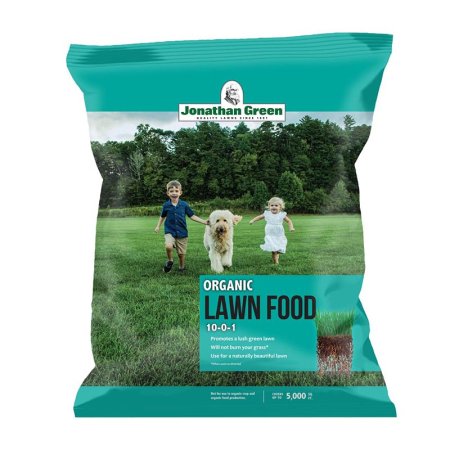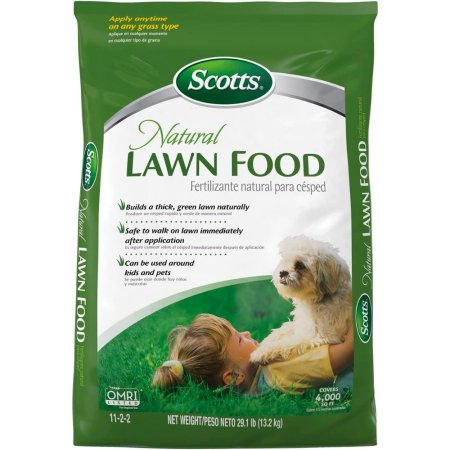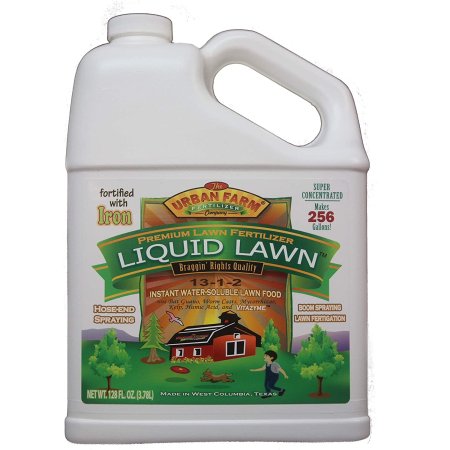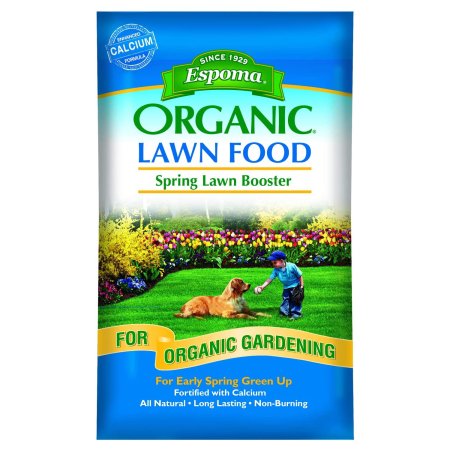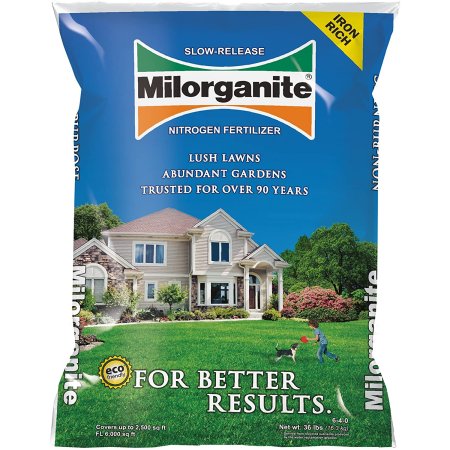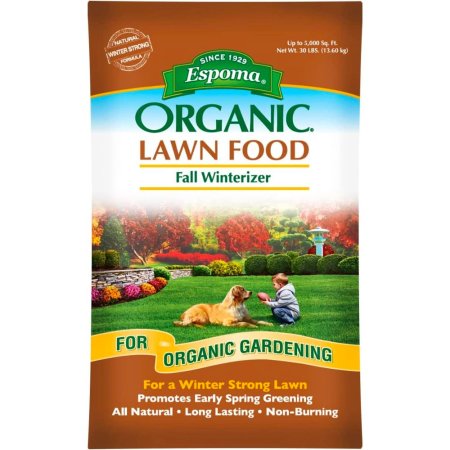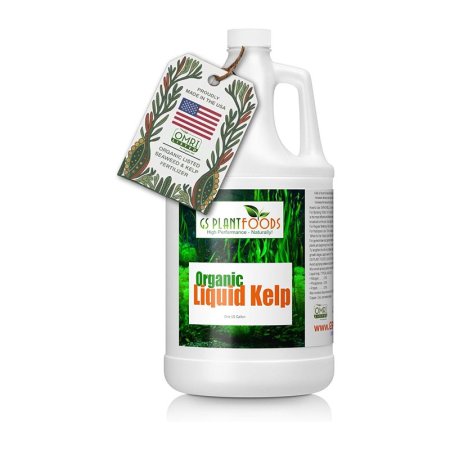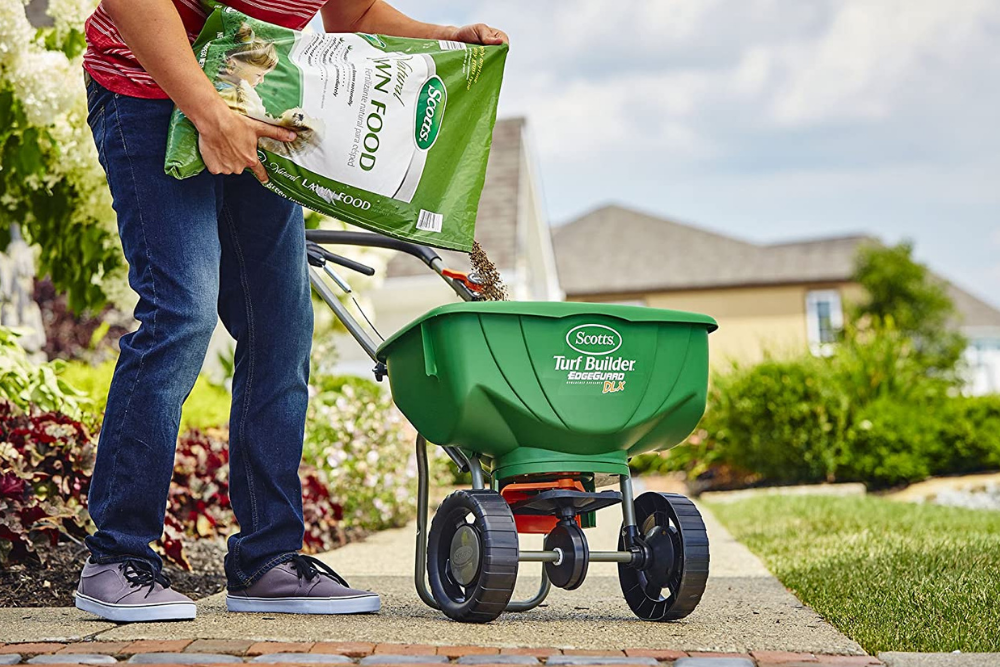
We may earn revenue from the products available on this page and participate in affiliate programs. Learn More ›
Along with mowing and watering, applying organic lawn fertilizers is an important part of creating a lush, healthy lawn. But while keeping your grass the right height and ensuring it gets enough to drink are relatively simple, choosing the proper natural lawn fertilizer is much more complicated. Factors like soil acidity, grass type, and time of year necessitate being somewhat selective about the lawn care products you choose.
To aid you in your efforts, we reached out to a lawn care expert for advice and researched dozens of good fertilizers before choosing the versatile and nonburning The Andersons Innova 7-1-2 Organic Fertilizer as our top pick. Still, depending on the season or specific species of grass you have, another pick might be more appropriate. Read on for our reviews of some of the best organic lawn fertilizers and helpful tips for selecting the right one.
- BEST OVERALL: The Andersons Innova 7-1-2 Organic Fertilizer
↓ Jump to Review - BEST BANG FOR THE BUCK: Jonathan Green Organic Lawn Food
↓ Jump to Review - BEST FOR P & K DEFICIENCY: Scotts Natural Lawn Food
↓ Jump to Review - BEST FOR N DEFICIENCY: Urban Farm Fertilizers 13-1-2 Liquid Lawn Fertilizer
↓ Jump to Review - BEST WITH NO PHOSPHORUS: Espoma Organic Lawn Food Spring Lawn Booster
↓ Jump to Review - BEST FOR DARK-GREEN LAWN: Milorganite 6-4-0 Slow-Release Nitrogen Fertilizer
↓ Jump to Review - BEST FOR FALL: Espoma Organic Lawn Food Fall Winterizer
↓ Jump to Review - BEST ORGANIC LIQUID: GS Plant Foods Organic Liquid Kelp Seaweed Fertilizer
↓ Jump to Review
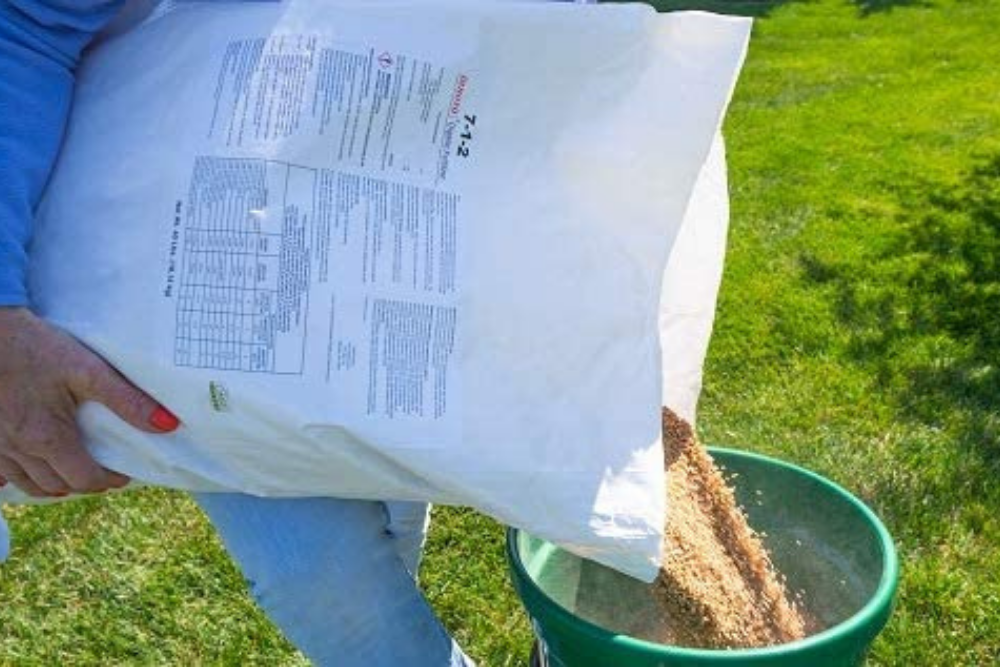
Before You Buy Organic Lawn Fertilizer
Choosing the best organic grass fertilizer requires an understanding of the lawn’s current condition. Is it generally healthy and simply needs regular feeding? Or does it display a nutrient deficiency of some kind? The type of grass will also determine which fertilizer to use. For example, fertilizers for St. Augustine grass will deliver different levels of nutrients than those for Bermuda grass.
Before buying and applying fertilizer, it’s smart to perform a soil test to identify your soil’s pH and nutrient content. These results will help you determine which organic natural fertilizer to apply as part of your personal DIY lawn-care program.
Organic Lawn Fertilizers Comparison Chart
| Product Name | NPK Ratio | Quantity | Coverage |
| The Andersons Innova 7-1-2 Organic Fertilizer | 7-1-2 | 40 pounds | 5,600 square feet |
| Jonathan Green Organic Lawn Food | 10-0-1 | 17 or 51 pounds | 5,000 or 15,000 square feet |
| Scotts Natural Lawn Food | 11-2-2 | 29.1 pounds | 4,000 square feet |
| Urban Farm Fertilizers 13-1-2 Liquid Lawn Fertilizer | 13-1-2 | 1 gallon (makes 256 gallons) | Up to 60,000 square feet |
| Espoma Organic Lawn Food Spring Lawn Booster | 8-0-0 | 30 pounds | 5,000 square feet |
| Milorganite 6-4-0 Slow-Release Nitrogen Fertilizer | 6-4-0 | 36 pounds | 2,500 square feet |
| Espoma Organic Lawn Food Fall Winterizer | 8-0-5 | 30 pounds | 5,000 square feet |
| GS Plant Foods Organic Liquid Kelp Seaweed Fertilizer | 0.3-0-0.6 | 1, 5, 55, or 275 gallon(s) | 1,000 square feet per gallon |
Our Top Picks
Each organic lawn treatment on our list of top picks is made from quality ingredients and provides essential nutrients for growing new grass or helping an existing lawn thrive.
Best Overall
The Andersons Innova 7-1-2 Organic Fertilizer
What We Like
- Minimal dust granules
- Suitable for many types of grass
- Formula won’t cause fertilizer burn
What We Don’t Like
- Only comes in 40-pound bags
Specs
- NPK ratio: 7-1-2
- Quantity: 40 pounds
- Coverage: 5,600 square feet
The Andersons Innova organic fertilizer is a slow-release formula that earned our top spot for its versatile 7-1-2 NPK ratio and amino acids that provide extended feeding without burning. It supplies a high percentage of highly digestible carbon to support beneficial soil microbes for a healthier growing environment. The OMRI (Organic Materials Review Institute)-listed fertilizer contains no biosolids, manure, composted waste products, or animal parts, making it an especially eco-friendly option. We also appreciate how little dust is produced during application, minimizing respiratory irritation that causes coughing and sneezing.
But more than our own comfort, we love this formula for what it does for our lawn. Even with accidental overapplication, it doesn’t cause turf burn and is safe to use adjacent to sensitive waterways and around kids and pets. Though this is an excellent all-around fertilizer for lawn grass, it only comes in 40-pound bags that cover up to 5,600 square feet each, which might be excessive for some.
Get The Andersons organic lawn fertilizer at Amazon.
Best Bang for the Buck
Jonathan Green Organic Lawn Food
What We Like
- Child- and pet-friendly lawn fertilizer
- Grass treatments last up to 10 weeks
- Plant- and animal-derived ingredients for added versatility
What We Don’t Like
- Not suitable for lawns requiring potassium
Specs
- NPK ratio: 10-0-1
- Quantity: 17 or 51 pounds
- Coverage: 5,000 or 15,000 square feet
Jonathan Green’s organic lawn care fertilizer food is a granular fertilizer made with a complex of plant and animal proteins, including feather meal, soybean meal, molasses, and wheat middlings. The 10-0-1 NPK slow-release formula delivers a boost of nitrogen plus iron to grow dark green grass for up to 10 weeks.
One of the things we like best about this budget-friendly pick is its safety profile. Unlike synthetic fertilizers, this product poses no risk of burning the grass, even if overapplied. Kids and pets can play on it immediately, and it can be used for both cold- and warm-season grasses and applied during spring, summer, or fall. The Jonathan Green fertilizer comes in two sizes: a 17-pound bag for up to 5,000 square feet of coverage and a 51-pound bag that feeds up to 15,000 square feet of lawn.
Get the Jonathan Green organic lawn fertilizer at Amazon, Walmart, or Johnathan Green.
Best for P & K Deficiency
Scotts Natural Lawn Food
What We Like
- Gentle enough for freshly seeded or sodded grass
- OMRI-listed and comes from natural sources
- Lawn is safe immediately after application
What We Don’t Like
- Relatively limited coverage area
Specs
- NPK ratio: 11-2-2
- Quantity: 29.1 pounds
- Coverage: 4,000 square feet
New and struggling lawns sometimes require a bit more phosphorus and potassium to boost root development and ensure drought tolerance, and with its 11-2-2 NPK content, the Scotts natural lawn food offers both. Made from natural sources like bone meal, blood meal, and meat meal, the formula is excellent for maintaining lawns across seasons and is suitable for all grass types, including zoysia grass.
The manufacturer recommends feeding up to four times through the growing season at 6- to 8-week intervals, and you should start seeing results within those first few weeks. Since the 29.1-pound bag only covers 4,000 square feet, you’ll probably need a few packages to make it through the year.
Get the Scotts organic lawn fertilizer at Amazon, The Home Depot, or Scotts.
Best for N Deficiency
Urban Farm Fertilizers 13-1-2 Liquid Lawn Fertilizer
What We Like
- Concentrated formula covers up to 60,000 square feet
- Iron helps produce deep green grass
- Includes animal- and plant-based ingredients
What We Don’t Like
- Recommended application frequency is 2 to 3 times per month
Specs
- NPK ratio: 13-1-2
- Quantity: 1 gallon (makes 256 gallons)
- Coverage: Up to 60,000 square feet
This super-concentrated liquid lawn fertilizer from Urban Farm Fertilizers boasts 13 percent nitrogen plus iron to help the grass grow and turn deep green at the beginning of spring. This innovative option goes beyond traditional picks by incorporating a blend of hydroponic-grade nutrients, mycorrhizae, humic acid, bacteria, enzymes, and minerals. Its 13-1- NPK content promotes rapid greening and growth for nutrient-deficient lawns.
The ingredients in this combination organic fertilizer come from bat guano, sea kelp, worm casings, and more, creating a concentrated formula that makes up 256 gallons of fertilizer to feed up to 60,000 square feet. However, the manufacturer does recommend you apply it two to three times each month, so you may end up needing more than one bottle to make it through the season. For best results, apply in the evening using a boom sprayer or hose. Dilution instructions for each option are on the back of the bottle.
Get the Urban Farm Fertilizers organic lawn fertilizer at Amazon, Walmart, or The Urban Farm.
Best with No Phosphorus
Espoma Organic Lawn Food Spring Lawn Booster
What We Like
- Includes calcium and sulfur for improved grass health
- Promotes disease resistance
- Made from feather meal, pasteurized poultry manure, and gypsum
What We Don’t Like
- Not suitable for lawns requiring potassium or phosphorus
Specs
- NPK ratio: 8-0-0
- Quantity: 30 pounds
- Coverage: 5,000 square feet
This lawn fertilizer for spring uses a moderate dose of slow-release nitrogen and a boost of calcium for deep greening and healthy growth with limited nutrient application. It has an NPK ratio of 8-0-0, 3 percent calcium, and 1 percent sulfur, and is made from feather meal, pasteurized poultry manure, and gypsum. Available in 30-pound bags, it can feed up to 5,000 square feet of lawn.
We love this pick for its ability to provide a sustained supply of nitrogen over time. This allows it to encourage the growth of thicker, greener grass and reduces the frequency of mowing required. It also won’t cause turf burn and is safe for people and pets. You can apply it to newly seeded and sodded areas in early spring to get a good crop of green grass growing.
Get the Espoma spring organic lawn fertilizer at Amazon or Walmart.
Best for Dark-Green Lawn
Milorganite 6-4-0 Slow-Release Nitrogen Fertilizer
What We Like
- Fortified with iron for a dark green lawn
- Feeds for up to 10 weeks
- Helps establish a healthy room system
What We Don’t Like
- Limited coverage area of 2,500 square feet
Specs
- NPK ratio: 6-4-0
- Quantity: 36 pounds
- Coverage: 2,500 square feet
In the early 1900s, the City of Milwaukee began reclaiming its wastewater on a massive scale and using it to make for-profit products. The name Milorganite comes from Milwaukee organic Nitrogen (nite), and the brand’s 6-4-0 slow-release nitrogen granular has had a consistent spot in the sheds of many home and professional landscapers throughout the many decades since its creation. Made from nutrient-rich heat-dried microbes that have digested the organic matter in wastewater, the resulting product is 85 percent organic matter. It encourages deep root development and can create healthy grass growth for up to 10 weeks after application.
In addition to nitrogen and phosphorus, this fertilizer contains 2.5 percent iron to encourage vibrantly green grass. As one of the most versatile picks on our list, it also makes a great garden fertilizer safe for flowers, vegetables, shrubs, and trees. As much as we love this pick and the story behind it, a 36-pound bag only feeds 2,500 square feet, so you’ll probably want to buy more than one bag.
Get the Milorganite organic lawn fertilizer at Amazon, Ace Hardware, The Home Depot, Walmart, or Target.
Best for Fall
Espoma Organic Lawn Food Fall Winterizer
What We Like
- Specifically formulated for winterizing lawns
- Works well as a Bermuda grass fertilizer
- Nonburning, even if overapplied
What We Don’t Like
- Not good for lawns needing phosphorus
Specs
- NPK ratio: 8-0-5
- Quantity: 30 pounds
- Coverage: 5,000 square feet
Looking for a way to prepare a lawn for a harsh winter and promote healthy spring growth? This 8-0-5 fertilizer from Espoma is designed to be used between September and November. It has extra potassium that helps lawns recover from summer stress while enhancing winter hardiness.
This slow-release formula is made from a blend of high-quality natural and organic ingredients, ensuring consistency and quality in every application. It’s nonburning, guaranteeing overfertilization isn’t an issue, and it’s suitable for all lawn types, including those that have recently been seeded or sodded. It is, however, best to apply this product to a dry lawn that has recently been mowed. A 30-pound bag will feed up to 5,000 feet.
Get the Espoma fall organic lawn fertilizer at Amazon or Walmart.
Best Organic Liquid
GS Plant Foods Organic Liquid Kelp Seaweed Fertilizer
What We Like
- OMRI-listed for organic food production
- Helps prevent having a drought-stressed lawn
- Works with other fertilizers for enhanced performance
What We Don’t Like
- Smell can be offputting, especially if used indoors
Specs
- NPK ratio: 0.3-0-0.6
- Quantity: 1, 5, 55, or 275 gallon(s)
- Coverage: 1,000 square feet per gallon
This organic kelp fertilizer from GS Plant Foods is dependent on one hero ingredient: Ascophyllum nodosum extract. Touted as one of nature’s miracle plant foods, the seaweed fortifies plants of all types, making it suitable for everything from lawns to flower beds, vegetable gardens, and houseplants. So long as its strong smell doesn’t bother you, you can even use it to extend the life of cut flowers.
The product comes in a 1-gallon bottle and is designed to be diluted with water at a ratio of 1 ounce of fertilizer to 1 gallon of water. The NPK ratio is 0.3-0-0.6, so nutrient levels are low, allowing this product to be combined with other types of fertilizers if desired. It also contains trace amounts of sulfur, magnesium, calcium, sodium, boron, iron, manganese, copper, zinc, and other carbohydrates and should be applied when temperatures are low to encourage nutrient uptake.
Get the GS Plant Foods organic lawn fertilizer at Amazon or GS Plant Foods.
Or, DIY Your Own Organic Lawn Fertilizer
While there are plenty of commercially produced organic lawn fertilizers on the market, it’s also possible to make a homemade fertilizer for lawns that delivers excellent results. A good fertilizer for grass should be about 50 percent organic matter and plant-based material, such as composted manure, garden clippings, decomposed leaves, sphagnum peat moss, sawdust, wood chips, or even seaweed. The other half of the fertilizer blend should contain slow-release sources of nitrogen such as blood meal, fish meal, cottonseed meal, feather meal, kelp meal, or soybean meal.
Once you have gathered the necessary materials for the homemade lawn fertilizer mix, start blending them in equal parts in a bucket or large container. Make sure to mix them thoroughly so it’s easy to apply everything evenly on your lawn.
Jump to Our Top Picks
Our Verdict
We love The Andersons Innova 7-1-2 Organic Fertilizer for its versatility and quality organic formula. Other popular lawn fertilizers, such as Scotts Turf Builder, Pennington UltraGreen Weed & Feed, and Spectracide Weed & Feed, are effective but do not meet our sustainability guidelines. We cannot recommend them in our list of the best organic lawn fertilizers due to their potentially harmful ingredients and negative impact on the environment.
How We Chose the Best Organic Lawn Fertilizers
We created this guide by drawing on our extensive experience covering home and garden products and comprehensive product research. We considered dozens of fertilizer options, primarily focusing on the following considerations before making our recommendations:
- Organic vs. inorganic: We only considered organic fertilizers for this guide since they are capable of top-notch performance without negative environmental impact.
- NPK ratio: Since different lawns have different macronutrient needs, we included formulations with various NPK (nitrogen/phosphorus/potassium) ratios.
- Value: Plant fertilizers vary widely in type and quantity. We ensured that each recommended product offered excellent value, regardless of the format.
What to Consider When Choosing the Best Organic Lawn Fertilizer
When choosing between the best organic lawn fertilizers on our list, consider type, ease of application, and the desired effect.
Type
Organic fertilizer ingredients fall into three types: animal-based, plant-based, and mineral-based. However, most products contain a combination of these types to deliver the best possible balance of major and minor nutrients. Some products may only offer a single ingredient or a blend of ingredients from a single type.
Animal-based fertilizers include blood meal, bone meal, feather meal, fish meal, and various manures. These products slowly break down over time, providing lawns and garden plants with season-long benefits.
Plant-based fertilizer ingredients include alfalfa meal, cottonseed meal, kelp meal, soybean meal, and compost. Soil microbes convert these materials into plant food much more quickly than animal products. They provide an immediate impact, often within days or weeks after application.
Mineral-based fertilizer ingredients like sulfur, dolomitic limestone, gypsum, greensand, and rock phosphate are naturally occurring concentrated forms of plant-food elements. They boost trace nutrient levels and eliminate deficiencies in the soil.
Liquid vs. Granular
Organic fertilizers, both liquid and granular, work with the naturally occurring microbes in the soil. When the fertilizer is applied to the soil, bacteria and fungi consume the natural ingredients and release the nutrients at a measured rate and in a form that is readily available to plants.
The difference between liquid and dry organic fertilizers is in the rate at which the soil consumes them. Dry granular formulations, which are applied using a fertilizer spreader, break down slowly and feed lawns over weeks or months. Liquid organic fertilizers deliver a quick boost of nutrients and work faster due to their minute particle size and embedded moisture.
NPK Ratio
Three elements make up the major nutrients that lawns and plants need for lush, green growth:
- Nitrogen (N) promotes green color and leafy growth.
- Phosphorus (P) stimulates deep root development.
- Potassium (K) boosts vigor and disease resistance.
Nitrogen is quite volatile. The amount not used by the lawn dissipates and must be regularly replenished. Phosphorus and potassium persist in the soil, so they are not required in such large quantities. On average, organic lawn fertilizer offers two to three times or more N compared to how much P and K are in the mix.
NPK ratios on fertilizer labels show the amount of each element present in the product as a percentage of the total weight, always in the order N-P-K. For instance, a product with a ratio of 11-2-2 contains 11 percent N, 2 percent P, and 2 percent K. Other ingredients and any additional nutrients will also be listed on the label.
Desired Effect
After a soil test (see the tips for using organic lawn fertilizer section below), it’s essential to factor the condition of the lawn into the fertilizer choice. Phosphorus is already sufficiently present in the soil in many areas. If your soil test shows levels are already high enough, you can help prevent pollution by not adding more.
If the grass is robust with dense foliage and deep green color, choose a fertilizer with a moderate to high amount of nitrogen (10 percent or greater) and little to no phosphorus and potassium. As the lawn approaches the dormant season in late summer and fall, apply fertilizer with a lower nitrogen ratio and slightly more potassium.
If your lawn is yellow or remains dull even when all three major nutrients are properly supplied, your grass may be deficient in iron. For a deeper green, choose a lawn fertilizer with supplemental iron.
Tips for Using Organic Lawn Fertilizer
There’s more to an effective organic lawn fertility program than simply applying fertilizer on a timed schedule. Don’t waste time and money by blindly applying fertilizer. First, test the soil, either with an over-the-counter testing kit from a local garden center or by sending a sample to your state’s Cooperative Extension Service for analysis. Then, use the results to map out a plan of action.
The first step should be to adjust the pH of the soil as indicated by test results. Establish the proper soil pH, between 5.8 and 7.2 depending on the grass species, to ensure that the grass can efficiently pull nutrients out of the soil. Lime raises the pH, while sulfur and aluminum sulfate lower it. Once the acidity is ideal, proceed with the necessary fertilizer application—and remember to mulch grass clippings.
- Use soil test results to determine fertility needs.
- Apply lime as necessary to maintain the proper soil pH and maximize fertilizer efficiency.
- Mulch grass clippings and leave them on the lawn to reduce fertilizer requirements by as much as 30 percent.
FAQs
The best organic fertilizer can help keep lawns vigorous and healthy. For more information on using fertilizers, check out the answers to these frequently asked questions.
Before purchasing a fertilizer, buy an over-the-counter soil test kit or send a soil sample to your county’s Cooperative Extension Service for analysis. Use the soil test results to guide fertilizer choice and application.
Grass will take up fertilizer throughout the growing season. The best times to apply it are when active growth begins in spring and again in midsummer as well as prior to winter to increase hardiness.
While organics are typically labeled as “nonburning,” excess fertilizer is a source of pollution. Follow soil test results and the instructions on the label of the specific product you are using.
Generally speaking, it’s unlikely you will cause fertilizer burn with an organic fertilizer. However, applying excess product is bad for the environment and your wallet.
The disadvantages of organic fertilizer are that it may cost more yet have lower levels of nutrients. Still, organic fertilizer has advantages like helping create healthier soil and providing nutrients at a more consistent rate.
The frequency with which you should apply organic fertilizer to your lawn depends on the product you’re using and the conditions of the soil. Generally speaking, however, you will need to fertilize anywhere from a few times a month to once every few months. To get the best results for your lawn, perform a soil test and follow the manufacturer’s instructions.
We spoke to Ryan Farley, the CEO of LawnStarter, an online marketplace that links you up with affordable lawn care services in your area, and he had this to say: “I tend to recommend fertilizing in the late afternoon or even a bit before sunset to avoid the hottest part of the day and give your fertilizer a chance to get into your soil overnight.”
While organic lawn fertilizer starts to get to work as soon as it’s applied, it will likely be at least a few days or even a couple of weeks before you start to notice its effects.




